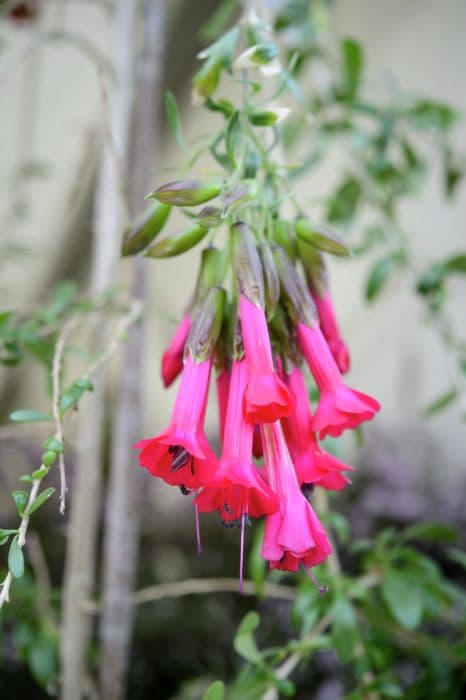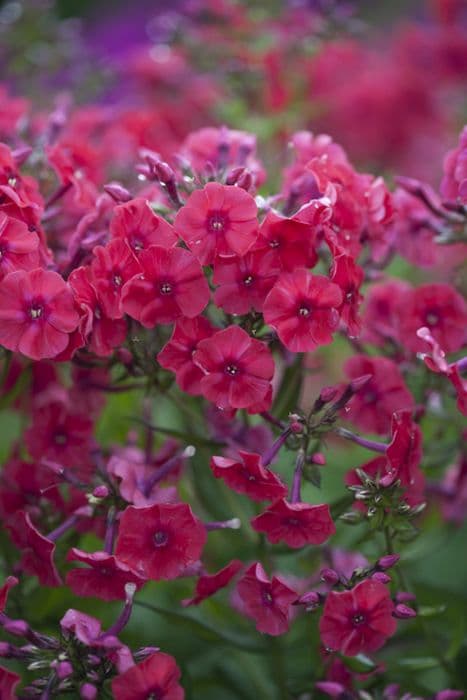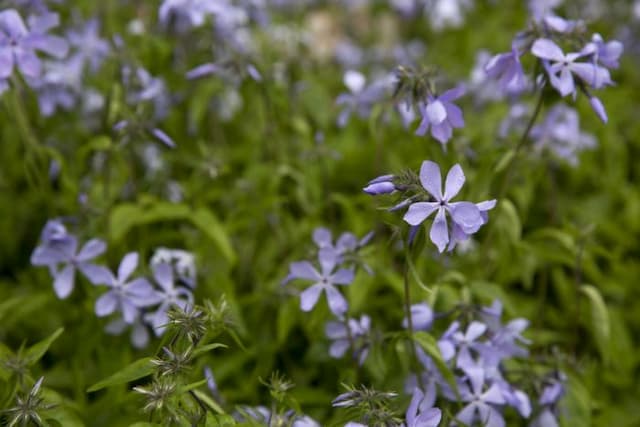Cathedral Bells Cobaea scandens f. alba

ABOUT
Cobaea scandens f. alba, commonly known as white cathedral bells, is a captivating climbing plant characterized by its vigorous growth habit. The distinct bell-shaped flowers of the plant are a pristine white, which bloom prolifically and are quite large compared to typical garden flowers. These blooms exude a subtle fragrance and have a fairy-tale appeal, reminiscent of old-fashioned gardens. The leaves of the white cathedral bells are compound, with each leaf made up of several leaflets. These leaflets are green and often have a slightly serrated edge, giving a lacy appearance to the foliage. Supporting their climbing nature, the plant develops tendrils that it uses to grip onto support structures like trellises, fences, and arbors. The stems of white cathedral bells are slender yet sturdy, allowing the plant to climb and spread with ease. Their overall growth habit provides a lush green backdrop punctuated by the striking white of its flowers. Adding to the visual allure, the stamens and pistil of the flowers are prominent, usually extending out from the bell-shaped corolla, and may have a touch of green or yellow tones, providing an interesting contrast to the white petals. As the season progresses, the flowers may develop a slight creamy or pale green hue, maintaining interest throughout its blooming period. In summary, white cathedral bells is a charming and robust climber with large, enchanting white flowers, delicate green foliage, and tendrils perfect for wrapping around garden supports. Its striking appearance makes it a favorite among gardeners who wish to add a touch of romance and vertical interest to their outdoor spaces.
About this plant
 Names
NamesFamily
Polemoniaceae
Synonyms
White Cathedral Bells, White Cup and Saucer Vine, White Mexican Ivy
Common names
Cobaea scandens var. alba, Cobaea lasseri.
 Characteristics
CharacteristicsLife cycle
Perennials
Foliage type
Deciduous
Color of leaves
Green
Flower color
White
Height
10 feet (3 meters)
Spread
10 feet (3 meters)
Plant type
Climber
Hardiness zones
9
Native area
Mexico
Benefits
 General Benefits
General Benefits- Aesthetic Appeal: Its attractive white flowers and lush green foliage enhance the beauty of gardens and outdoor spaces.
- Fast Growth: Cobaea scandens f. alba, commonly known as Cup and Saucer Vine, has a rapid growth rate, quickly covering trellises, fences, and other structures.
- Shade Production: Thanks to its dense foliage, it can create shaded areas, providing relief from the sun in outdoor living spaces.
- Privacy Screen: It can be used to form a natural privacy barrier, obscuring unwanted views and creating a sense of seclusion.
- Pollinator Attraction: The flowers can attract bees, butterflies, and other beneficial insects, supporting local ecosystems.
- Vertical Gardening: Its climbing nature makes it ideal for vertical gardening, saving space in smaller garden areas while adding visual interest.
- Seasonal Interest: The plant provides seasonal interest with its flowering period and can be used to add variety in gardens with its distinct white blooms.
 Medical Properties
Medical PropertiesThis plant is not used for medical purposes.
 Air-purifying Qualities
Air-purifying QualitiesThis plant is not specifically known for air purifying qualities.
 Other Uses
Other Uses- Cup and Saucer Vine can be used as a natural screen or privacy wall when grown along fences or trellises, effectively blocking out unwanted views or nosy neighbors.
- The rapid growth of Cup and Saucer Vine makes it an ideal candidate for covering unsightly structures, such as old sheds or walls, giving them a verdant, lively facade.
- This vine can serve as a living curtain on a pergola or gazebo, providing not only shade but also a romantic and whimsical aesthetic.
- Cup and Saucer Vine's sturdy vines can be trained to grow into unique shapes or patterns, making it a good plant for creative topiary gardening.
- The plant can be used in large hanging baskets to create dramatic vertical gardening displays, with vines cascading over the sides.
- With its attractive blooms, Cup and Saucer Vine can serve as a focal point in a garden design, drawing the eye and adding vertical interest to the landscape.
- Gardeners can use the rapid and dense growth of Cup and Saucer Vine to quickly fill in garden gaps, providing a lush backdrop for other flowering plants.
- The plant can be used in butterfly gardens, as its flowers attract a variety of pollinators, including butterflies and hummingbirds.
- Cup and Saucer Vine can be included in educational gardens to illustrate the concept of coiling climbers and how plants adapt to their environment to reach sunlight.
- For outdoor events or weddings, the Cup and Saucer Vine can be used decoratively to create natural archways or embellish ceremonial backgrounds.
Interesting Facts
 Feng Shui
Feng ShuiThe Cup and Saucer Vine is not used in Feng Shui practice.
 Zodiac Sign Compitability
Zodiac Sign CompitabilityThe Cup and Saucer Vine is not used in astrology practice.
 Plant Symbolism
Plant Symbolism- Opportunity: Also known as the Cathedral Bells, Cobaea scandens f. alba symbolizes new opportunities due to its rapid and enthusiastic climbing nature.
- Growth and Expansion: Its vigorous growth habit reflects personal or spiritual expansion, and the idea of reaching new heights in life.
- Mystery and Wonder: The bell-shaped flowers and the vine's ability to grow in unexpected ways give it a sense of mystery and wonder, intriguing onlookers.
- Messages and Communication: The Cathedral Bells can symbolize the transmission of messages, relating to the way a bell tower might spread sound across distances.
 Water
WaterFor the Cup and Saucer Vine, it's essential to maintain evenly moist soil, particularly during its active growing season in the spring and summer. Water thoroughly once the top inch of soil feels dry to the touch, which could be once a week, depending on temperature and humidity. Generally, you should aim to provide around 1 gallon of water per week. During winter, reduce watering to every couple of weeks or when the soil is dry, as the plant's water needs decrease when growth slows.
 Light
LightThe Cup and Saucer Vine thrives in full sun to partial shade. It performs best when it receives at least 6 hours of sunlight a day. Place it in a spot where it can get plenty of morning light and some shade during the hottest part of the afternoon to prevent leaf scorch.
 Temperature
TemperatureThe Cup and Saucer Vine prefers temperatures between 50 and 75 degrees Fahrenheit for optimal growth. It can survive minimum temperatures down to around 40 degrees Fahrenheit but it is frost-sensitive. Ideal conditions are warm and consistent temperatures without the risk of frost exposure.
 Pruning
PruningPruning the Cup and Saucer vine encourages bushier growth and more blooms. It is best to prune in late winter or early spring before new growth begins. Remove any dead or damaged growth, and you can also cut back vines that have become too long to maintain the desired shape.
 Cleaning
CleaningAs needed
 Soil
SoilThe Cathedral Bells (Cobaea scandens f. alba) thrives best in a well-draining soil mix with a pH range of 6.0 to 7.5. A suitable soil mix can be created by combining two parts loam, one part peat, and one part sharp sand to ensure proper drainage and aeration. Adding organic compost to the mix can also help provide the necessary nutrients for optimal growth.
 Repotting
RepottingCathedral Bells should be repotted every 2-3 years to prevent root-bound conditions and to replenish nutrients in the soil. Choose a pot that is one size larger than the current one to give the roots room to grow.
 Humidity & Misting
Humidity & MistingCathedral Bells prefers a moderate to high humidity level, ranging from 50% to 70%, to thrive. This plant enjoys a humid environment, but good air circulation is also important to prevent any fungal diseases.
 Suitable locations
Suitable locationsIndoor
Provide bright light, stake for support, and maintain warmth.
Outdoor
Place in full sun to partial shade, with structure for climbing.
Hardiness zone
9-11 USDA
 Life cycle
Life cycleCobaea scandens f. alba, commonly known as Cup and Saucer Vine, starts its life cycle as a seed, generally requiring warmth to germinate after which it rapidly grows into a seedling. The vine then enters its vegetative stage, developing a vigorous, climbing stem and large, pinnate leaves that allow it to cover structures swiftly. As it matures, it starts to produce large, bell-shaped white flowers, typically during late summer through to autumn, which are pollinated by bees and other insects. After successful pollination, the plant produces fruit in the form of large seed capsules containing the seeds for the next generation. During its growing season, Cobaea scandens f. alba requires adequate support, water, and nutrients to reach its full growth and flowering potential. In regions where it is not hardy, the vine dies back at the first frost, but where it can overwinter, it becomes a perennial, restarting its cycle the following spring.
 Propogation
PropogationPropogation time
Spring
The most popular method of propagating Cup and Saucer Vine (Cobaea scandens f. alba) is through seeds. Typically, it is best to sow the seeds in early spring, once the risk of frost has passed. You can start the seeds indoors, about 6 to 8 weeks before the average date of last frost, to give them a head start. Fill small pots with a well-draining potting mix, and plant the seeds 1 inch deep, watering them thoroughly. Cover the pots with a plastic bag or a propagator lid to maintain humidity and keep them in a warm spot with temperatures around 70°F (about 21°C). Germination can take anywhere from two to four weeks. Once the seedlings emerge and grow strong enough, transplant them to their final location after acclimatizing them to outdoor conditions.









